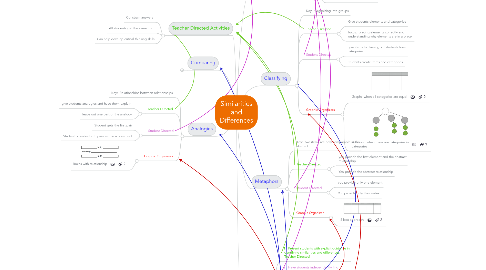
1. Analogies
1.1. Key: Relationships between relationships
1.2. Teacher Directed
1.2.1. give students analogies and have them explain
1.2.2. leave out one part of the analogy
1.3. Student Directed
1.3.1. Student gets the first pair
1.3.2. Student provides both pairs within a constraint
1.4. Graphic Organizers
1.4.1. Boxes with relationship
2. Comparing
2.1. Key: identify important characteristics
2.2. Teacher Directed
2.2.1. Teacher chooses characteristics
2.2.2. Teacher chooses items to compare
2.3. Student Directed
2.3.1. Students select characteristics
2.3.2. Students select items to compare
2.4. Graphic Organizers
2.4.1. Venn diagram
2.4.2. Comparison matrix
3. Teacher Directed Activities
3.1. Constrain answers
3.2. All students get the same info.
3.3. Can help develop critical thinking skills
4. Classifying
4.1. Key: Organizing into groups
4.2. Teacher Directed
4.2.1. Give students elements and categories
4.2.2. focus: placing elements correctly and understanding why elements are in a place.
4.3. Student Directed
4.3.1. give items to classify, but students form categories.
4.3.2. Students create items and categories
4.4. Graphic Organizers
4.4.1. Graph: when all categories are equal
4.4.2. Bubbles: when there are categories in categories
5. Metaphors
5.1. Key: two items are only comparable in the abstract
5.2. Teacher-Directed
5.2.1. you provide the first element and the abstract relationship
5.2.2. You provide the abstract relationship
5.3. Student Directed
5.3.1. you provide only one element
5.3.2. You provide only the context
5.4. Graphic Organizer
5.4.1. 5 box approach
